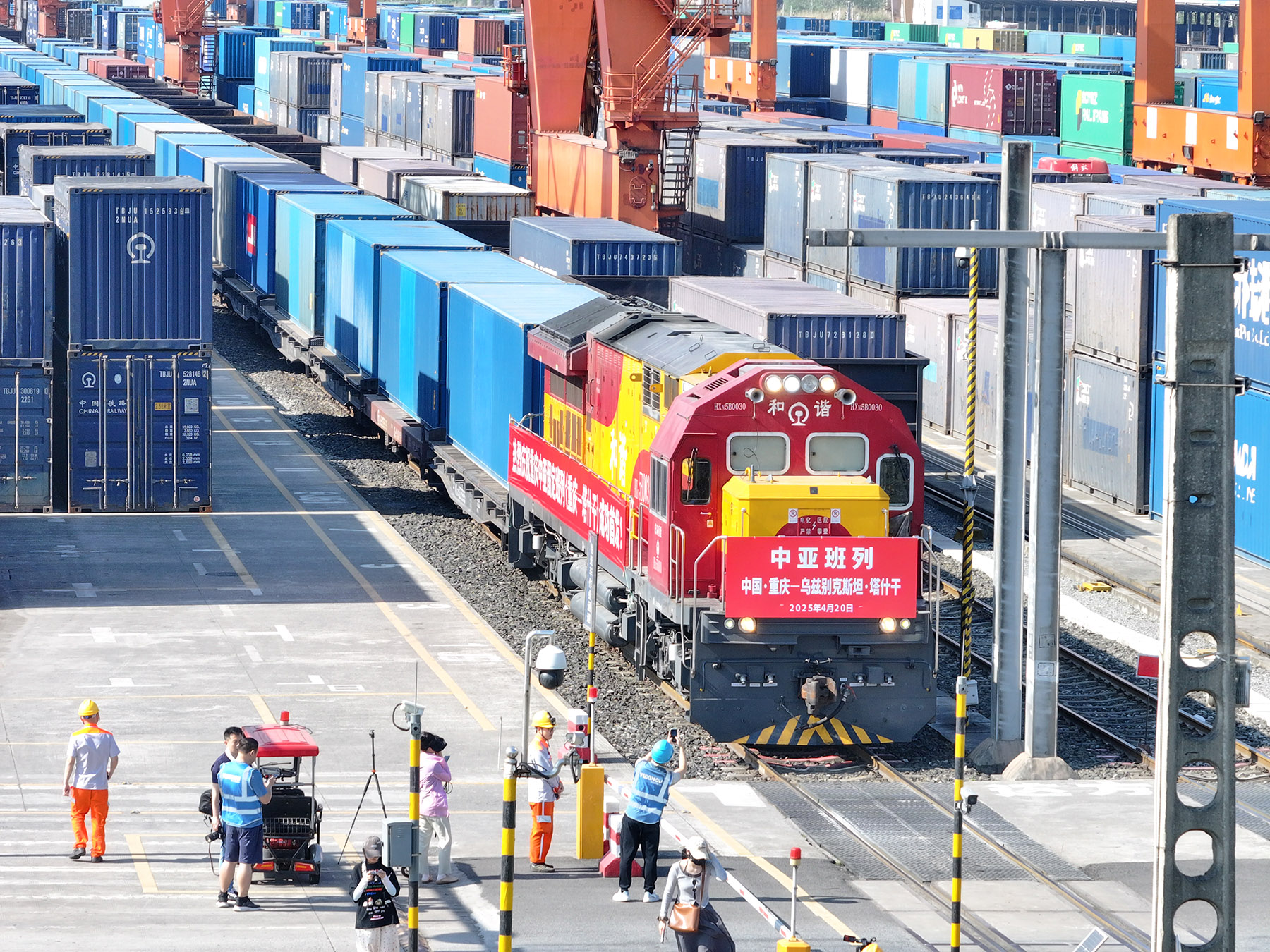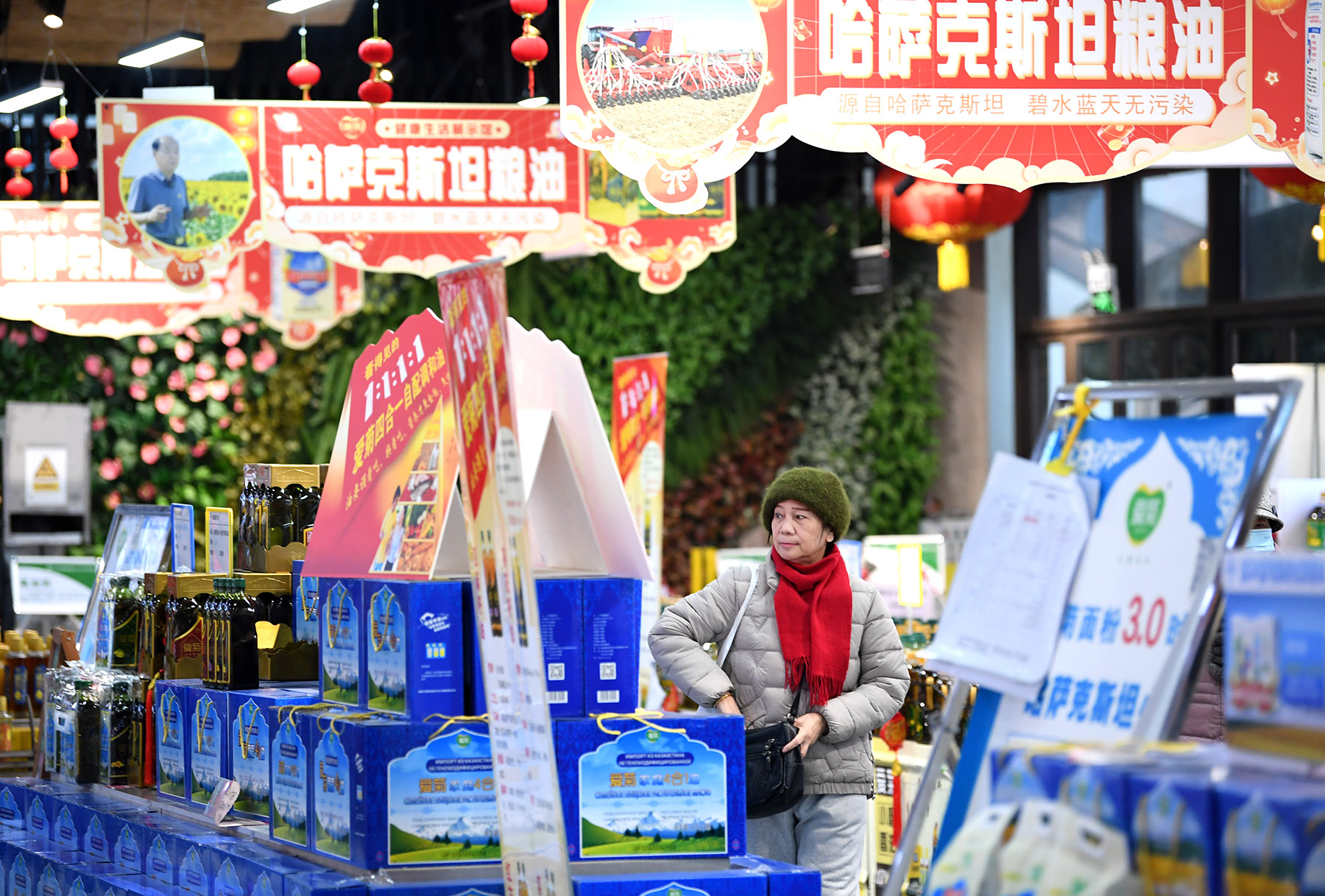Freight train helping goods from Central Asia reach major global ports directly via Tianjin Port and enabling cargo from Japan, South Korea and Southeast Asia to arrive at trade destinations

Over 2,000 years ago, Zhang Qian was sent on a mission to Western regions, opening up the ancient Silk Road that connected the East and the West.
This marked the beginning of bilateral exchanges between China and Central Asia, a relationship that has lasted for over two millennia.
Through mutual learning and support, both sides have left behind remarkable stories and legends in the history of human civilization.
Fast forward to today, the long whistle of a train signals a new chapter in this enduring relationship.
READ MORE: China's railway cargo transportation volume up in Jan-Feb
On May 20, a freight train to Central Asia loaded with automobile parts, construction materials, and other goods left from Tianjin Port, officially marking the departure of the first direct train to Tashkent, Uzbekistan, in 2025.
This so-called "steel camel caravan", spanning 5,018 kilometers, is more than an ordinary international freight train operation.
It is a vivid example of the China-Uzbekistan joint construction of the Belt and Road Initiative, injecting new momentum into deepening connectivity across the Eurasian continent and promoting regional economic cooperation.
As a double landlocked country, Uzbekistan has long faced logistical constraints due to limited transportation channels. The launch of this freight train creatively integrates the maritime advantages of Tianjin Port with the land-based network of Central Asia, establishing a seamless "sea-rail intermodal" transportation system.
This innovative logistics solution not only allows goods from Central Asia to reach major global ports directly via Tianjin Port, but also enables cargo from Japan, South Korea and Southeast Asia to penetrate deep into Central Asia through this corridor.
The "steel camel caravan" is emblematic of multilateral cooperation, weaving a dense network of trade and collaboration.
From Xi'an to Chongqing, from Yiwu to Tianjin, the expanding "circle of friends" of the China-Europe freight trains reflects the vitality of the Belt and Road Initiative, which has become a powerful driver of connectivity and economic growth across regions.
Sadvakkas Seitzhanov, general manager of the Chinese branch of KTZ Express, a subsidiary of Kazakhstan's national railway company Kazakhstan Temir Zholy, closely monitors the freight data of trains departing from Xi'an every day at Xi'an International Trade and Logistics Park. If necessary, he directly contacts the Kazakhstan headquarters for coordination.
According to data from the Chinese Ministry of Commerce quoting KTZ, the China-Kazakhstan railway transported 2.8 million metric tons of goods in January this year, marking an 18 percent year-on-year increase. A previous report showed that the cargo volume between the two countries in 2024 reached 32 million tons, reflecting a 13.1 percent year-on-year growth.

Seitzhanov said KTZ established an office in Xi'an because the northwest city has become a key transfer hub and warehouse, facilitating the movement of goods between China, Central Asia and even Europe.
"We adjust the shipment schedule based on real-time market demand, share information about the train service, and provide one-stop service to our clients," he said.
The significance of this collaboration extends beyond logistics.
At the China-Central Asia Summit held in 2023, China vowed to enhance connectivity through measures such as accelerating port upgrades and developing China-Europe freight train hubs.
One notable outcome of the summit is the China-Kazakhstan (Xi'an) Trade Logistics initiative, jointly launched by KTZ Express and Xi'an Free Trade Port Construction and Operation last December.
Sun Weidong, secretary-general of the secretariat of the Central Asia-China format, emphasized that China-Central Asia relations have leapfrogged under the strategic guidance of leaders, with cooperation in various fields showing even broader prospects.
He highlighted recent high-level visits, such as Kyrgyz president's successful visit to China earlier this year. These exchanges have deepened strategic partnerships and strengthened bilateral relations.
China and Kazakhstan are committed to creating a new "Golden Thirty Years" in their bilateral relations, while China and Tajikistan are working toward developing a comprehensive strategic partnership for a new era. Meanwhile, China continues to maintain close high-level exchanges with other Central Asian countries.
Under the Belt and Road Initiative, China and Central Asian countries have strengthened strategic alignment and carried out comprehensive cooperation based on mutual benefit.
Last year, trade between the two sides reached a record $94.8 billion, with China serving as the most important investment and trade partner for Central Asian countries.
China's "new three" products — electric vehicles, solar batteries, and lithium-ion batteries — have provided strong momentum for exports to Central Asia, while cooperation in areas such as digital trade, modern agriculture and the green economy has flourished. Highlights have emerged in local economic and trade exchanges, cross-border transportation cooperation has developed rapidly, and the China-Kyrgyzstan-Uzbekistan railway project has been launched.
Additionally, China has shared its successful experiences with Central Asian countries in fields such as poverty alleviation, desertification control and ecological protection.
The connectivity of infrastructure effectively reduces the cost of international trade for participating economies in the Belt and Road Initiative, enhancing their ability to integrate with the global economy and stimulating stronger development momentum.
A research by the Asian Development Bank shows that a 10 percent reduction in infrastructure-related trade costs can lead to a 20 percent increase in exports for landlocked countries.
Zhang Wenlin, vice-president of Kangtai Plastic Science & Technology Group, recently returned from a business trip to Uzbekistan and Kazakhstan with managers of other Chengdu-based enterprises.
He believes the Central Asian region holds great development potential, though challenges coexist with opportunities, requiring in-depth understanding and long-term commitment.
"At present, there are still many opportunities in the Central Asian market," Zhang said. "This region is vast, with substantial market capacity in areas such as infrastructure construction and urban renewal."
ALSO READ: Rail freight from Hebei makes way to Hanoi
He added that the company plans to take a "two-step" approach moving forward: First, it will form a dedicated foreign trade team for Russian-speaking regions to explore the market and quickly collaborate with business partners through trade. Second, it plans to establish a factory in Kazakhstan and is currently coordinating with various industrial parks to conduct preliminary research.
"For businesses going global, the most important thing is to operate legally and compliantly, showcasing robust capabilities to truly achieve mutual benefit and win-win outcomes," Zhang said.
Song Yangchao, general manager of Chengdu GengXin Furniture Co Ltd, agreed with Zhang's viewpoint.
His company signed a cooperation agreement with Eco Wood Plyus, the largest furniture enterprise in the Tashkent region of Uzbekistan, intending to form a joint venture and preparing to share production technology.
"I believe Central Asia is a very dynamic market, bringing new development opportunities for many domestic enterprises," Song said, adding that the company will focus on refining the cooperation plan to present it to relevant authorities.
He concluded that regional cooperation is an important component of practical collaboration between China and Central Asia. Under the leadership of heads of State and the impetus of the China-Central Asia Summit, friendly exchanges and cooperation at the local level between China and Central Asia are becoming increasingly close.
Contact the writer at renqi@chinadaily.com.cn


